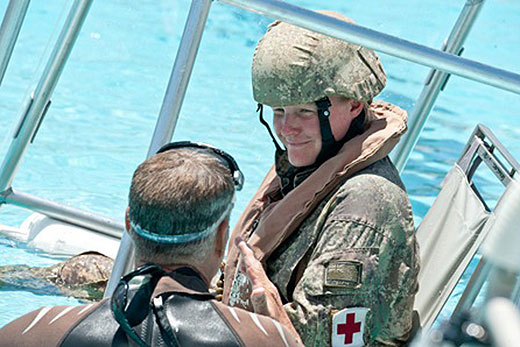Uniformed members of New Zealand armed forces have grown by 530 since mid-2013 on the back of plummeting attrition and strong morale.
Today there are 9035 sailors, soldiers and airmen and women in the New Zealand Defence Force, up from 8504 in June 2013, an increase of six percent.
More people are appearing on the frontline.
The Defence Force today totals 14,116 military and civilian staff, its highest staffing levels since 2011.
Moderate growth in frontline numbers was signalled by the recent Defence Mid-Point Rebalancing Review.
This positive people picture is consistent with the Defence Force's latest Annual Report, which came out today, says Chief of Defence Force, Lieutenant General Tim Keating.
It also identifies a big drop in the number of people choosing to leave, combined with growth in recruiting, which is allowing the Defence Force to address the impacts of a spike in attrition experienced in late 2011/early 2012.
'Trade groups and ranks in the three Services that reduced during the one-off spike in attrition two-and-a-half years ago continue to be restored,” Lieutenant General Tim Keating, writes in the report.
'The training ‘pipelines' of the three services are full. Retention and re-enlistment efforts over the past year have continued to be successful.”
Attrition, the rate of people leaving the Defence Force, has dropped to levels only seen during the global financial crisis when people chose to stay in uniform because of uncertainty in the wider economy.
Today they appear to be staying because of a lift in confidence and morale, says Lieutenant General Keating.
The Annual Report points to the Defence Force's organisational health survey, which shows 89 per cent of people in the Defence Force rated their overall satisfaction with their employment as excellent, good or satisfactory – up from 81 per cent in 2013.
When asked about the morale in their workplace, 86 per cent of respondents rated it as satisfactory or better compared to 79 percent in 2013.
Regular Force attrition – those people in uniform – is currently 10.12 per cent against a long-term historical average of 14.62 per cent.
For each of the Services there has been an improvement, but most dramatically so in Navy, where attrition has fallen to 7.99 per cent today from 15.91 per cent in June 2013.
This is the lowest attrition in the Navy's modern history. Army attrition is 12.4 per cent and Air Force's 7.7 per cent. Civilian attrition is 11.94 per cent.
The Annual Report (which is for the year ended June 30) notes a number of strategies to regenerate the Navy were successful, with sailor numbers growing by seven per cent, attrition falling by 39 per cent, and morale and satisfaction perceptions increasing by 20 per cent.
As previously reported, this Annual Report confirms Navy continued to prioritise Offshore Patrol Vessels (OPVs) to deliver patrol tasks in our EEZ over the use of Inshore Patrol Vessels.
The OPVs delivered 103 percent of their planned sea days.
'This, and an expected further reduction in personnel attrition next year, will provide a platform for gradual but steady workforce regeneration,” the Annual Report says.
The Army reports that its land forces continued to sustain overseas deployments as well as supporting other agencies in New Zealand and the Pacific.
'Land combat forces remained prepared for a wide range of operational contingencies.” The Annual Report noted that there had been an improvement in the Army's trained state but that people numbers in a small number of specialist trades would have challenged follow-on rotations of deployed forces, had these been required, with Army suggesting they would have met these tasks by switching experienced troops from trainer roles into operational ones. New Zealand's Special Operations Forces reported being 'fully prepared” and 'available at the appropriate degree of notice” against all scenarios.
The Royal New Zealand Air Force reports that their personnel state has improved over the year, with attrition now within what is considered their 'optimal range”.
Regular Force strength is 99.5 per cent of planned.
Air Force note, however, that people numbers in some trade groups remain fragile, in particular Flying Instructors and Avionics Technicians.



0 comments
Leave a Comment
You must be logged in to make a comment.